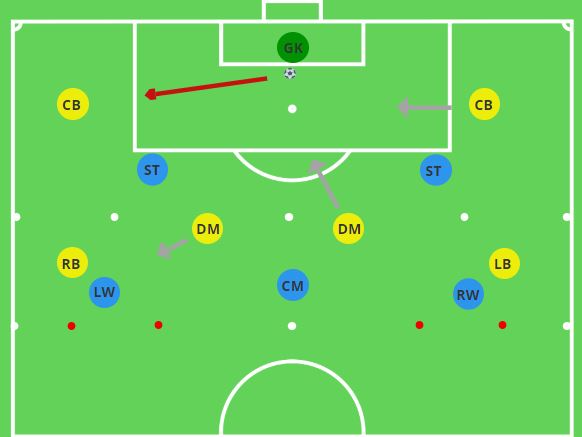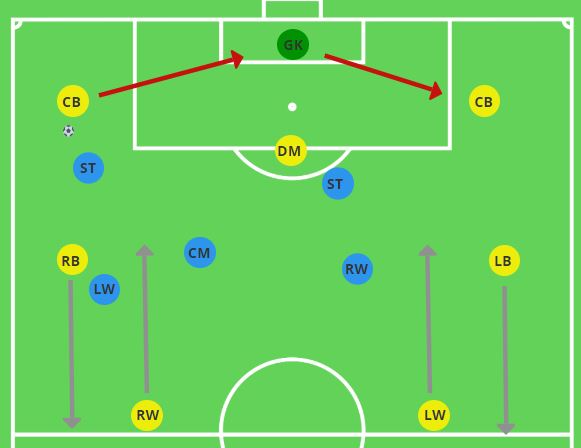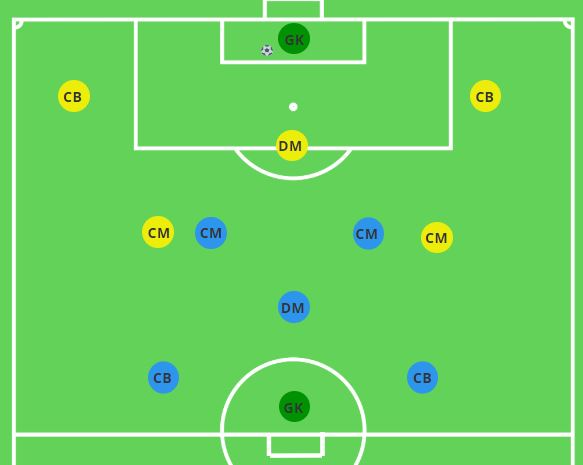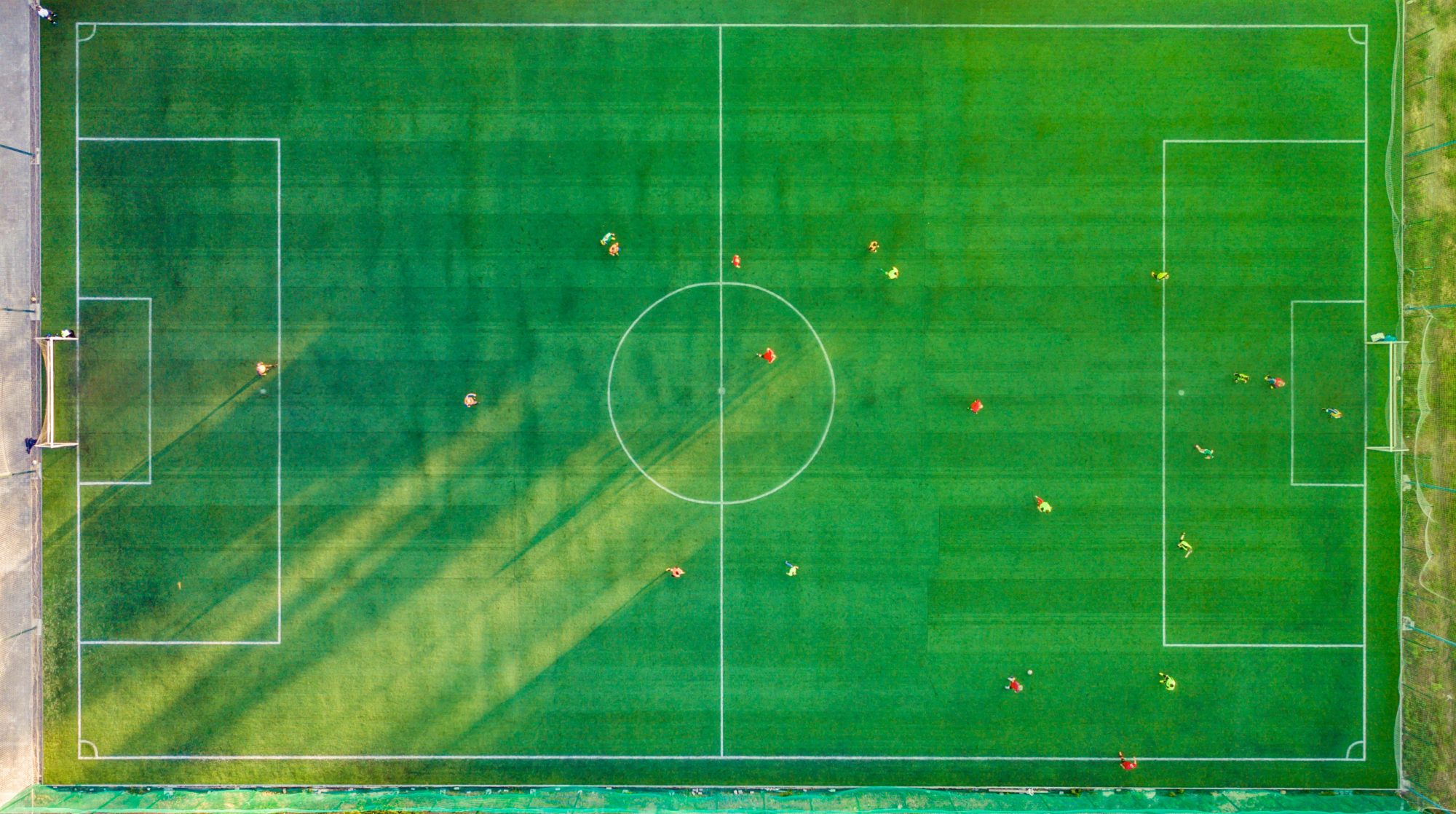INTRODUCTION
Embed from Getty ImagesPlaying out from the back is far from a new concept, but the importance it has taken on in the last decade has grown immensely in the modern game. Nearly every team strives to play out from the back and with the recent rule change to allow defenders inside their own penalty area on goal kicks, playing out from the back is set to become even more encouraged for every team on the planet. Some less familiar to football may question why teams would want to play the ball around their own half off of goal kicks, rather than just clearing it away to the other half. However, playing out from the back is actually a far less dangerous option. Hoofing the ball up the field creates a 50/50 with the other team, allowing the other team the potential to regain possession. Meanwhile playing out from the back or building out of the back allows teams to keep possession of the ball through short and quick passes. From a youth development perspective, playing out of the back is far more beneficial for all players than just one player kicking it up the field as far as they can in hopes that a fast, physical player will get on the end of it. Instead when playing out of the back, more players get the opportunity to touch the ball and work on the basics of the game while developing tactical knowledge on the proper ways to play football. Here is a complete session plan on playing out from the back for U11-U15 players. Enjoy!
P.S. Also be sure to check out our latest 2020 Playing out from the Back Session Plan!
SESSION NOTES
In any session topic, it is important to consider what area of the field the topic takes place in most often during a game and which players are most heavily involved. With playing out from the back, it is a bit obvious exactly where on the field and who the players involved need to be. As a result, this session plan will take place in the attacking team’s own half and involve mostly defenders, midfielders and goalkeepers. The “defending” team on the other hand (the team going against the team playing out from the back) will involve mostly attack-minded players who will look to press the opposition and make life difficult for them. This will give it that game-realistic feel which sometimes can become lost in other sessions based on playing out from the back where players just work on synchronized passes and movements without any opposition defenders going up against them.
1. WARM-UP: POSITIONAL RONDO – 7v5

SET-UP
12 players 1 ball 5 bibs 12 cones 30 x 30 area
In this warm-up activity, two imbalanced teams will go up against each other in a battle to keep possession of the football. The set-up for this positional rondo will be a 7v5 advantage for the attacking team to allow more options for playing out from the back. The set-up pictured above involves a back four and two central midfielders for the yellow team, while only attack-minded players will take part in the activity for the blue team. The yellow team have set up with a 3v2 in one end (including the goalkeeper), which will quickly become a 4v2 with the dropping movement of one of the defensive midfielders, who will act as the pivot. In the other end, the team will have a 3v3, but the pivot can rejoin to create a 4v3 advantage.
Based on your formation and the players in which you would like to use to play out from the back, you can set this up however suits the needs of your team. The important pieces to take away are that the attacking team should have the advantage over the defending team and that a line can be created halfway through the field (15 yards) to help players understand the concept of breaking a line and playing in between the lines. The set up can also include two goals (marked by the red cones in the image) for the yellow team to score on and a net for the blue team to score on, which the goalkeeper is using to play out from the back. However, the warm-up activity is just a positional rondo, so targets are not necessary right away and will probably be more effective as a progression.
The set up starts with the centre-backs spreading wide and the fullbacks spreading high. The pivot (number 6/defensive midfielder) drops in to the middle to fill in the gap left by the centre backs, while the other central midfielder looks to create space on the near side in between the lines. This method of playing out from the back is one of the most common in world football today and even has a special name – La Salida Lavolpiana -from the former Boca Juniors and Mexico National Team coach Ricardo La Volpe. With the pivot dropping in toward the goal and the goalkeeper remaining a potential passing option to switch play, the team in possession will have a 4v2 numerical advantage, which they can use to unbalance the opposition and play through the lines. With the pivot rejoining the other zone when the ball is played in to a fullback or central midfielder, a 4v3 will be created in the other area. For more on La Salida Lavolpiana see Futbol Decoded – The Evolution of La Salida Lavolpiana.
RULES
In this activity, all restarts begin with the goalkeeper playing out from the back to either one of the two centre-backs or the pivot (defensive midfielder) if they deem this to be the best option. To start, both teams are looking to just keep possession of the ball. The yellow team will look to cause an imbalance for the blue team through quick, short passes. Meanwhile the disadvantaged blue team will look to pressure the ball, force mistakes, and simultaneously work to stay compact and narrow. If they regain possession, the blue team will look to pass it around and keep possession themselves.
All players are locked into their zones except for the two defensive midfielders, who are allowed to move freely between zones. They are however encouraged to balance each other’s movement.
KEY COACHING POINTS
- Timing of the runs, particularly from defensive midfielders.
- Short & quick passes.
- Shifting of key players toward the middle (particularly if possession is lost to blue), but also simultaneously maintaining shape and width when possible to create opportunities for switches of play.
- Don’t play into pressure, work to switch play and change direction through use of the goalkeeper or pivot if closed down instead.
- Positional rotation, changes of speed and changes of direction to catch the opposition team off-balance
- Attacking team (yellow) should work to make the field big. Defending team (blue) should work to make the field small.
- Every player (except goalkeeper) should have a backwards or sideways option to play at all times.
PROGRESSION

Once players have got the hang of the key coaching points of playing out from back, the activity can be progressed into one with targets for both teams. Two small goals can be set up for the yellow team to score on, while the blue team can score on what should be an already in place large goal. This will give the team building out from the back something to work toward, while also incentivizing the blue team to really put on the pressure and work to win the ball back so that they can score.
2. ANALYTICAL ACTIVITY: METHODS OF PLAYING OUT FROM THE BACK

SET-UP
13 players 1 ball 5 bibs 44 x 50 area
In this analytical activity, the coach is given the opportunity to work closely with the players on the various methods in which the team will look to play out from the back. The yellow team will have either a 7v5 advantage over the blue team, looking to score by crossing the half-way line or an 8v5 advantage over the blue team, looking to play in a target player. All restarts will begin with the goalkeeper.
RULES & SUGGESTIONS
The yellow team will look to build out from the back and score a goal by either crossing the halfway line or finding a target player on the other side of the halfway line. The blue team meanwhile will look to pressure the yellow team into a mistake and look to score on the large goal. The halfway line from the previous activity is removed and players are now free to move anywhere on the field. However, players will be encouraged to follow a set of synchronized movements, patterns or positional rotations based on how the coach wishes to play out from the back. To see how my 9v9 team plays out of the back using a 3-2-3 formation see -> Coaching the 3-2-3 (9v9). The following are some of the various methods and coaching points that coaches can focus on within this activity:
- Inverted fullbacks (right and left defenders taking up positions in more central areas.
- Inverted wingers (right and left wingers who come central as the fullbacks push high and high)
- Playing through the central midfielders (timing of the runs and off-the ball movement)
- Triangle passing and movement off the ball to create triangular shapes
- Positional rotation (ex: central midfielder dropping in the fullback’s position and fullbacks pushing high)
- Creation of a strong side to switch play over to the other side where the opposition will be unbalanced
- Playing in between the lines
For my team I would pick 2-3 methods that I think would benefit them the most and then work on progressing each method one by one through the set-up of the analytical activity. For this article I will focus on Switching Play and Positional Rotation within this activity.
Switching Play

In this pattern of play, the blue team has pressed and closed down the potential forward passing options of the yellow team. As a result, the yellow centre back will look to change direction and switch the point of attack via use of the goalkeeper. This is made possible via the width maintained by the opposite side centre back and fullback who have stayed wide even despite the shifting of the blue team. Their ability to maintain their width is also made possible by the pivot dropping in and the near-sided defensive midfielder remaining in front of the blue team’s central midfielder. With this change of direction, the yellow team can quickly switch the point of attack and exploit the weak side of the blue team where they now have the advantage.
With this pattern of play there are two more important things to note. First, as the ball is played to the goalkeeper, the striker can begin to shift to the left side and try to help with the exploitation of space. Secondly, the pass from the centre back to the goalkeeper must be a quick, short pass along the ground. This is a much more preferable option than a sideways pass to the defensive midfielder as the blue striker in this case can quickly close them down. If the fullback is going to play in the pivot instead, they should drop immediately and create space in behind. However, the goalkeeper is already naturally going to be in a great position to switch the point of attack, so this is not necessary. The above image is a great example of what coaches mean when they talk about the creation of a strong side in order to exploit space on the other side. This can be used anywhere on the field, but is a particularly popular and useful method of playing out from the back.
Positional Rotation

Now that the players have understood the concept of switching play and the creation of a strong side to create space on the other side, we then progress into positional rotation. With only 13 players involved in this activity, positional rotation can be a bit more difficult. However, this very simple method of positional rotation will be very easy for youth players to understand. The diamond that has been created at the back between the two centre backs, goalkeeper and defensive midfielder will work to switch play until they can find an opportunity to take advantage of an overload. Meanwhile, the fullbacks have pushed high and wide, hopefully pulling their markers with them. This will then create more space for the wingers to exploit as they take up positions either centrally or out wide. With this rotation, the goal is to catch the blue team off-balance and cause confusion for them on who to mark. To accomplish this, the yellow team can be spoken to in private prior to the start of this progression. The blue team should work to react to the movements of the yellow team without prior knowledge of what’s coming, just as they wouldn’t know exactly what the attacking team is going to do in a game. The coach can then debrief the concept of positional rotation to catch the opposition off-balance to both teams at a stoppage of play or at the end of the activity.
KEY COACHING POINTS
- Timing of the runs from all players.
- Short & quick passes.
- Shifting of key players toward the middle (particularly if possession is lost to blue), but also simultaneously maintaining shape and width when possible to create opportunities for switches of play.
- Don’t play into pressure, work to switch play and change direction through use of the goalkeeper or pivot if closed down instead.
- Positional rotation, changes of speed and changes of direction to catch the opposition team off-balance
- Attacking team (yellow) should work to make the field big. Defending team (blue) should work to make the field small.
- Look for gaps in between the lines
- Every player (except goalkeeper) should have a backwards, forwards and sideways option to play at all times.
3. SMALL SIDED GAME – 6v6

SET-UP
12 players 1 ball 6 bibs 44 x 50 area
To keep with the theme of playing out from the back, the session now progresses into a small sided game with two balanced teams. All restarts will start with the goalkeeper to continue to encourage the topic at hand. This small sided game and topic in general can work better with greater numbers, however 12 players is a more realistic number of attendees for a typical practice session. With 12 players in attendance I would personally set the teams up in a 2-1-2 with the front 2 being more like central midfielders rather than forward-thinking players and the 1 being the defensive midfield pivot. I believe this is the best way to balance the important players for the topic and replicate what will occur during the game.
However, to expand on the small-sided game and go beyond what has been learned up until this point, each team will devise a tactic or method of playing out from the back. Players should be encouraged to build upon the methods of playing out from the back that they learned in the previous practice. For example, when I last did this session the two methodologies we talked about were positional rotation and switching play. So I had the two teams each devise a tactic or pattern of play that coincided with either positional rotation or switching play. This puts the players in charge of their own learning and is a great way for the players to be more autonomous for the decisions that they are making, allowing them to solve problems on their own, rather than the coach giving the players all the answers. The last time I did this session for my U12 girls, one of the teams devised a tactic to utilize the goalkeeper whenever possible. This is a great tactic because in this activity the goalkeeper is rarely going to be pressured, they are almost always going to be open, and they can see the entire field. Another time, one of the teams devised a strategy of playing as many give-and go’s as possible, emphasizing their off-the-ball movement and the key concept of quick and short passes. The best part about this was that the players came up with these ideas all on their own based on their previous knowledge of the topic and what they had already learned during the practice. This is a great way to mix up any small sided game but works particularly well with topics that involve patterns of play such as playing out from the back and triangle passing or defensive tactics like pressing and individual marking. When stopping play, the same key coaching points that have been applied in the previous activities can be applied again. However, here are some more new ones that can also be added into the mix.
KEY COACHING POINTS
- Short & quick passes. If the pass is too slow or too fast, an interception is very likely.
- Work to counter the opponent’s anticipation with your movement and passing.
- Look for gaps in between the lines. Players higher up the field (ex: advanced central midfielders) need to be unmarked and in behind the opponents.
- Open body shape to play forward when possible.
- Every player (except goalkeeper) should have a backwards, forwards and sideways option to play at all times.
- Constant movement and scanning. Understanding the right time push up, hold or drop. Don’t just stand still when you get into space, it’s a constant process of scanning and moving.
- Can we split the opponent? Can we eliminate several defenders with a killer pass at the right moment?
- Can we keep possession through passes in and around our own 18-yard box until the exact right moment to play the perfect forward combination?
With more players you can then progress as a final step to a large-sided game or keep it to just the small-sided game. The important thing is just to emphasize playing out from the back, the key coaching points of the topic and ensuring the players are now in charge of their own learning and that you take more of a back-seat in this final game, fully allowing the players to express what they have learned.
CONCLUSION
So there it is! An entire session plan all about playing out from the back! This session plan puts the players in charge of their own learning, while teaching them key concepts related to building out from the back and keeping possession of the ball in general. Make sure to check out more of our Session Plans and our brand new 2020 Playing out from the Back Session Plan. Hope you enjoyed this article and hope to see you soon.
More on Playing out from the Back…
-> Playing Out From The Back – The Basics
-> Playing out from the Back (9v9)
-> Playing Out From The Back – Session Plan and Coaching Points (2020 Edition)
-> Playing Forwards vs. Backwards – Session Plan and Coaching Tips


Great session, but can you update it with CBs being able to be inside the 18 ? Is there a huge difference in playing out with that in mind?
LikeLike
CBs should always start inside the 18. The ball travels too far if outside the 18 which allows the opposition more time to press.
LikeLike